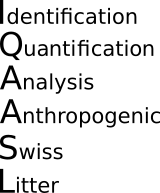Lakes and rivers
Contents
# -*- coding: utf-8 -*-
# This is a report using the data from IQAASL.
# IQAASL was a project funded by the Swiss Confederation
# It produces a summary of litter survey results for a defined region.
# These charts serve as the models for the development of plagespropres.ch
# Data is gathered by volunteers.
# Please remember all copyrights apply, please give credit when applicable
# The repo is maintained by the community effective January 01, 2022
# There is ample opportunity to contribute, learn and teach
# contact dev@hammerdirt.ch
# Dies ist ein Bericht, der die Daten von IQAASL verwendet.
# IQAASL war ein von der Schweizerischen Eidgenossenschaft finanziertes Projekt.
# Es erstellt eine Zusammenfassung der Ergebnisse der Littering-Umfrage für eine bestimmte Region.
# Diese Grafiken dienten als Vorlage für die Entwicklung von plagespropres.ch.
# Die Daten werden von Freiwilligen gesammelt.
# Bitte denken Sie daran, dass alle Copyrights gelten, bitte geben Sie den Namen an, wenn zutreffend.
# Das Repo wird ab dem 01. Januar 2022 von der Community gepflegt.
# Es gibt reichlich Gelegenheit, etwas beizutragen, zu lernen und zu lehren.
# Kontakt dev@hammerdirt.ch
# Il s'agit d'un rapport utilisant les données de IQAASL.
# IQAASL était un projet financé par la Confédération suisse.
# Il produit un résumé des résultats de l'enquête sur les déchets sauvages pour une région définie.
# Ces tableaux ont servi de modèles pour le développement de plagespropres.ch.
# Les données sont recueillies par des bénévoles.
# N'oubliez pas que tous les droits d'auteur s'appliquent, veuillez indiquer le crédit lorsque cela est possible.
# Le dépôt est maintenu par la communauté à partir du 1er janvier 2022.
# Il y a de nombreuses possibilités de contribuer, d'apprendre et d'enseigner.
# contact dev@hammerdirt.ch
# sys, file and nav packages:
import datetime as dt
# math packages:
import pandas as pd
import numpy as np
from scipy import stats
from statsmodels.distributions.empirical_distribution import ECDF
# charting:
import matplotlib as mpl
import matplotlib.pyplot as plt
import matplotlib.dates as mdates
from matplotlib import ticker
from matplotlib import colors
from matplotlib.colors import LinearSegmentedColormap
from matplotlib.gridspec import GridSpec
import seaborn as sns
# home brew utitilties
import resources.sr_ut as sut
import resources.chart_kwargs as ck
# images and display
# from PIL import Image as PILImage
from IPython.display import Markdown as md
# from IPython.display import display
from myst_nb import glue
# set some parameters:
start_date = "2020-03-01"
end_date ="2021-05-31"
start_end = [start_date, end_date]
a_fail_rate = 50
unit_label = "p/100m"
a_color = "saddlebrown"
# colors for gradients and charts
cmap2 = ck.cmap2
colors_palette = ck.colors_palette
# colors for the individual survey areas
bassin_pallette = {"rhone":"dimgray", "aare":"salmon", "linth":"tan", "ticino":"steelblue", "reuss":"purple"}
# set the maps
bassin_map = "resources/maps/lakes_rivers_map.jpeg"
# define the feature level and components
this_level = "river_bassin"
comps = ["linth", "rhone", "aare", "ticino"]
# proper labels for charts and tables
comp_labels = {"linth":"Linth", "rhone":"Rhône", "aare":"Aare", "ticino":"Ticino", "reuss":"Reuss"}
top_name = ["All survey areas"]
# common aggregations
agg_pcs_quantity = {unit_label:"sum", "quantity":"sum"}
agg_pcs_median = {unit_label:"median", "quantity":"sum"}
# aggregation of dimensional data
agg_dims = {"total_w":"sum", "mac_plast_w":"sum", "area":"sum", "length":"sum"}
# columns needed
use_these_cols = ["loc_date" ,
"% buildings",
"% to trans",
"% recreation",
"% ag",
"% woods",
"population",
this_level,
"water_name_slug",
"streets km",
"intersects",
"length",
"groupname",
"code"
]
# get the data:
dfBeaches = pd.read_csv("resources/beaches_with_land_use_rates.csv")
dfCodes = pd.read_csv("resources/codes_with_group_names_2015.csv")
dfDims = pd.read_csv("resources/corrected_dims.csv")
# set the index of the beach data to location slug
dfBeaches.set_index("slug", inplace=True)
# make any adjustments to code definitions here:
dfCodes.set_index("code", inplace=True)
codes_to_change = [
["G74", "description", "Insulation foams"],
["G940", "description", "Foamed EVA for crafts and sports"],
["G96", "description", "Sanitary-pads/tampons, applicators"],
["G178", "description", "Metal bottle caps and lids"],
["G82", "description", "Expanded foams 2.5cm - 50cm"],
["G81", "description", "Expanded foams .5cm - 2.5cm"],
["G117", "description", "Expanded foams < 5mm"],
["G75", "description", "Plastic/foamed polystyrene 0 - 2.5cm"],
["G76", "description", "Plastic/foamed polystyrene 2.5cm - 50cm"],
["G24", "description", "Plastic lid rings"],
["G33", "description", "Lids for togo drinks plastic"],
["G3", "description", "Plastic bags, carier bags"],
["G204", "description", "Bricks, pipes not plastic"],
["G904", "description", "Plastic fireworks"],
["G211", "description", "Swabs, bandaging, medical"],
]
for x in codes_to_change:
dfCodes = sut.shorten_the_value(x, dfCodes)
# the surveyor designated the object as aluminum instead of metal
dfCodes.loc["G708", "material"] = "Metal"
# make a map to the code descriptions
code_description_map = dfCodes.description
# make a map to the code materials
code_material_map = dfCodes.material
1. Lakes and rivers¶
Map of survey locations IQAASL March 2020 - May 2021.
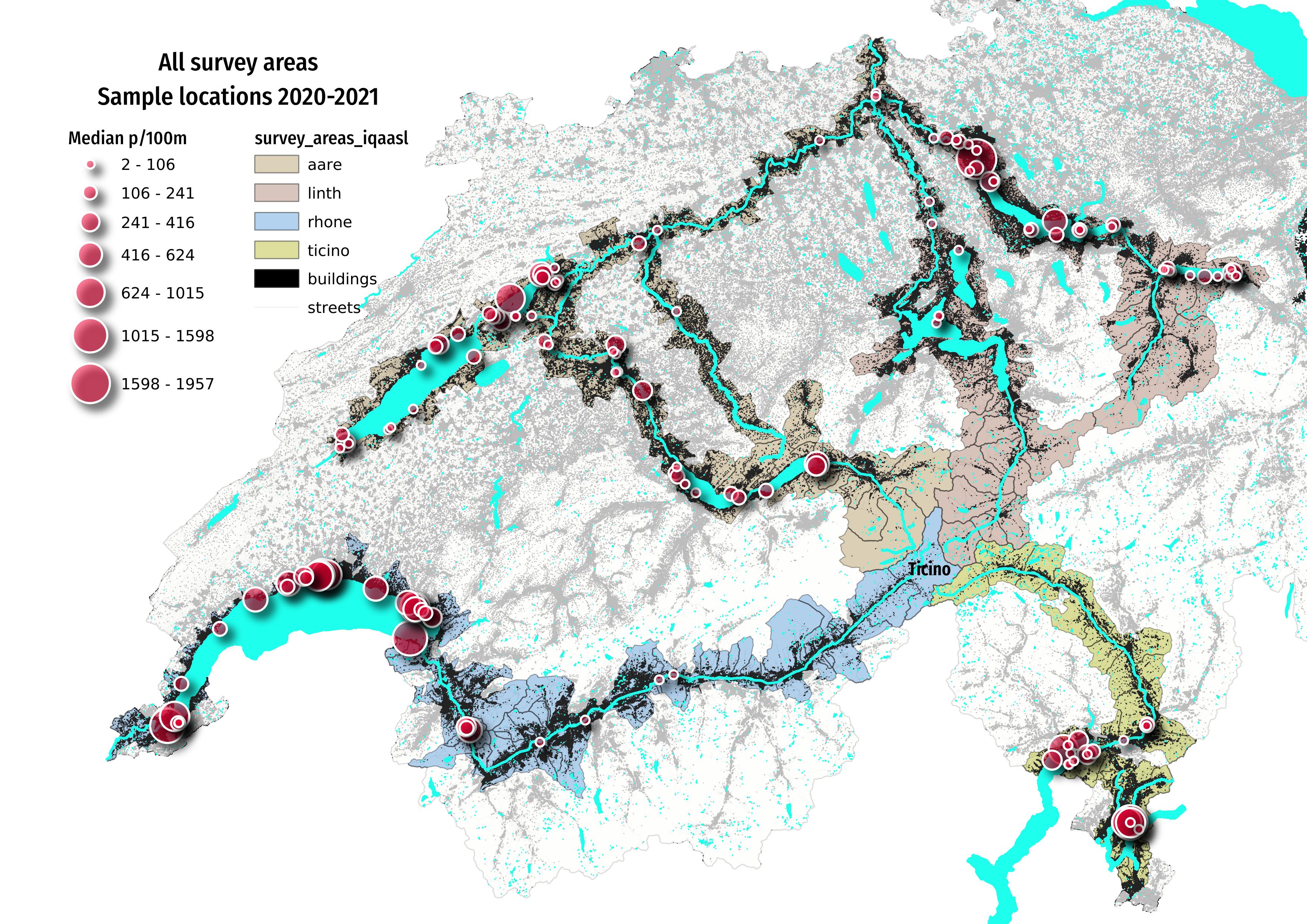
Fig. 1.1 ¶
Figure 1.1: The survey locations were grouped by survey area for analysis. The size of the marker is set by the median survey total for that location.
1.1. Land use profile¶
The survey areas are grouped by river catchment systems, this report combines several catchment areas for analysis of regional trends:
Aare : Emme, Aare
Linth: Reuss, Linth, Limmat
Rhône: Rhône
Ticino: Ticino, Lago di Lugano, Laggo Maggiore
The land use profile is the percent of total area attributed to each land use category within a 1500m radius of each survey location.
% of land attributed to buildings
% of land attributed to agriculture
% of land attributed to forestry
% of land attributed to recreation
Streets are reported as the total number of kilometers of streets within the 1500m radius. Intersects are an ordinal ranking of the number of rivers/canals that intersect a lake within 1500m of the survey location.
The ratio of the number of samples completed at the different land use profiles is an indicator of the environmental and economic conditions that the samples were taken in.
For more information Land use profiles
Distribution of land use characteristics
# this is the data before the expanded fragmented plastics and foams are aggregated to Gfrags and Gfoams
before_agg = pd.read_csv("resources/checked_before_agg_sdata_eos_2020_21.csv")
before_agg["loc_date"] = list(zip(before_agg.location, before_agg["date"]))
# this is the aggregated survey data that is being used
fd = pd.read_csv(F"resources/checked_sdata_eos_2020_21.csv")
fd["loc_date"] = list(zip(fd.location, fd["date"]))
fd.rename(columns={"% to agg":"% ag", "% to recreation": "% recreation", "% to woods":"% woods", "% to buildings":"% buildings"}, inplace=True)
# explanatory variables
luse_exp = ["% buildings", "% recreation", "% ag", "% woods", "streets km", "intersects"]
# cumulative statistics for each code
code_totals = sut.the_aggregated_object_values(fd, agg=agg_pcs_median, description_map=code_description_map, material_map=code_material_map)
dt_nw = fd.groupby(use_these_cols[:-2], as_index=False).agg({unit_label:"sum"})
sns.set_style("whitegrid")
fig, axs = plt.subplots(2, 3, figsize=(9,9), sharey="row")
for i, n in enumerate(luse_exp):
# get the dist for each survey area here
r = i%2
c = i%3
ax=axs[r,c]
for element in comps:
the_data = ECDF(dt_nw[dt_nw[this_level] == element][n].values)
sns.lineplot(x=the_data.x, y=the_data.y, ax=ax, label=comp_labels[element], color=bassin_pallette[element])
# get the dist for all here
a_all_surveys = ECDF(dt_nw[n].values)
sns.lineplot(x=a_all_surveys.x, y=a_all_surveys.y, ax=ax, label="All surveys", color="magenta", linewidth=2.5)
# get the median from the data
the_median = np.median(dt_nw[n].values)
# plot the median and drop horzontal and vertical lines
ax.scatter([the_median], 0.5, color="red",s=50, linewidth=2, zorder=100, label="the median")
ax.vlines(x=the_median, ymin=0, ymax=0.5, color="red", linewidth=2)
ax.hlines(xmax=the_median, xmin=0, y=0.5, color="red", linewidth=2)
# format the % of total on the xaxis:
if i <= 3:
if c == 0:
ax.set_ylabel("Ratio of samples", **ck.xlab_k)
ax.xaxis.set_major_formatter(ticker.PercentFormatter(1.0, 0, "%"))
else:
pass
ax.set_xlabel(n, **ck.xlab_k)
handles, labels = ax.get_legend_handles_labels()
ax.get_legend().remove()
ax.set_title(F"median: {(round(the_median, 2))}",fontsize=12, loc="left")
plt.tight_layout()
plt.subplots_adjust(top=.88, hspace=.35)
plt.suptitle("Land use within 1500m of the survey location", ha="center", y=1, fontsize=16)
fig.legend(handles, labels, bbox_to_anchor=(.53,.94), loc="center", ncol=6)
glue("eosluse", fig, display=False)
plt.close()
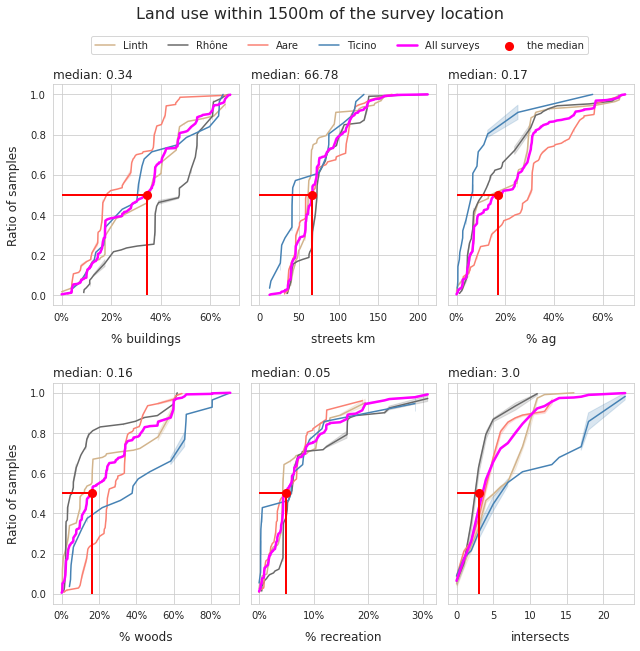
Fig. 1.2 ¶
Figure 1.2: The survey locations in the Rhône and Linth survey areas had the greatest median amount of land attributed to buildings at 47% and 40% and the least amount attributed to woods at 5% and 8% respectively. The Aare survey area had the lowest median amount of land attributed to buildings at 16% and the greatest amount of land attributed to agriculture at 30%. The land attributed to recreation represents sports fields, public beaches and other public gathering places.
1.2. Cumulative totals by survey area¶
# aggregate the dimensional data
dims_parameters = dict(this_level=this_level,
locations=fd.location.unique(),
start_end=start_end,
agg_dims=agg_dims)
dims_table = sut.gather_dimensional_data(dfDims, **dims_parameters)
dt_all = fd.groupby(["loc_date","location",this_level, "city","date"], as_index=False).agg({unit_label:"sum", "quantity":"sum"})
for name in dims_table.index:
dims_table.loc[name, "samples"] = fd[fd[this_level] == name].loc_date.nunique()
dims_table.loc[name, "quantity"] =fd[fd[this_level] == name].quantity.sum()
# add proper names for display
dims_table["Survey area"] = dims_table.index.map(lambda x: comp_labels[x])
dims_table.set_index("Survey area", inplace=True)
# get the sum of all survey areas
dims_table.loc["All survey areas"]= dims_table.sum(numeric_only=True, axis=0)
# for display
dims_table.sort_values(by=["quantity"], ascending=False, inplace=True)
dims_table.rename(columns={"samples":"samples","quantity":"items", "total_w":"total kg", "mac_plast_w":"plastic kg", "area":"m²", "length":"meters"}, inplace=True)
# format kilos and text strings
dims_table["plastic kg"] = dims_table["plastic kg"]/1000
dims_table[["m²", "meters", "samples", "items"]] = dims_table[["m²", "meters", "samples", "items"]].applymap(lambda x: "{:,}".format(int(x)))
dims_table[["plastic kg", "total kg"]] = dims_table[["plastic kg", "total kg"]].applymap(lambda x: "{:.2f}".format(x))
# make table
data = dims_table.reset_index()
fig, axs = plt.subplots(figsize=(len(data.columns)*1.5,len(data)*.8))
sut.hide_spines_ticks_grids(axs)
table_one = sut.make_a_table(axs, data.values, colLabels=data.columns, colWidths=[.22, *[.13]*6],a_color=a_color)
table_one.get_celld()[(0,0)].get_text().set_text(" ")
table_one.set_fontsize(14)
plt.tight_layout()
glue("eos_summary_sarea", fig, display=False)
plt.close()
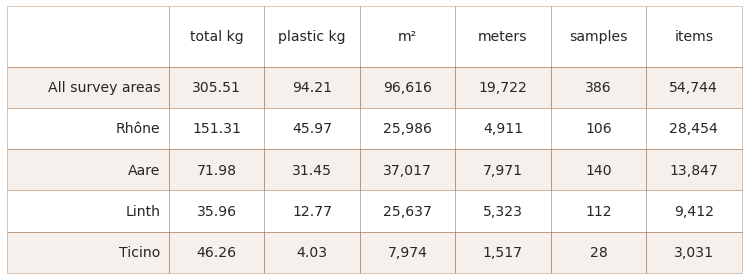
Fig. 1.3 ¶
Figure 1.3: Dimensional result totals for all survey areas. The Aare survey area had the greatest number of samples and the least number of total objects collected.
1.3. Survey results all objects¶
Distribution of survey results. Values are presented as the number of pieces identified per 100 meters (p/100 m).
# the surveys to chart
dt_all["date"] = pd.to_datetime(dt_all["date"], format="%Y-%m-%d")
fd_n_samps = dt_all.loc_date.nunique()
fd_dindex = dt_all.set_index("date")
# monthly median survey total
monthly_plot = fd_dindex[unit_label].resample("M").median()
# scale the chart as needed to accomodate for extreme values
y_lim = 95
y_limit = np.percentile(dt_all[unit_label], y_lim)
# months locator, can be confusing
# https://matplotlib.org/stable/api/dates_api.html
months_loc = mdates.MonthLocator(interval=1)
months_fmt = mdates.DateFormatter("%b")
# days = mdates.DayLocator(interval=7)
fig, axs = plt.subplots(1,2, figsize=(10,5))
rate = "Monthly"
line_label = "monthly median"
ax = axs[0]
sns.scatterplot(data=fd_dindex, x="date", y=unit_label, hue=this_level, palette=bassin_pallette, alpha=0.8, ax=ax)
sns.lineplot(data=monthly_plot, x=monthly_plot.index, y=monthly_plot, color="magenta", label=line_label, ax=ax)
ax.set_ylim(0,y_limit)
ax.set_xlabel("")
ax.set_ylabel(unit_label, **ck.xlab_k14)
ax.xaxis.set_major_formatter(months_fmt)
ax.get_legend().remove()
axtwo = axs[1]
lake_dts = fd.groupby([this_level, "loc_date"], as_index=False)[unit_label].sum()
for i, a_name in enumerate(fd[this_level].unique()):
label=comp_labels[a_name]
a_ecdf = ECDF(lake_dts[lake_dts[this_level] == a_name][unit_label].values)
sns.lineplot(x=a_ecdf.x, y=a_ecdf.y, color=bassin_pallette[a_name], ax=axtwo, label=label)
r_bassin = ECDF(dt_all[unit_label].values)
sns.lineplot(x=r_bassin.x, y=r_bassin.y, color="magenta", label=top_name[0], linewidth=2, ax=axtwo)
axtwo.set_xlabel(unit_label, **ck.xlab_k14)
axtwo.set_ylabel("Ratio of samples", **ck.xlab_k14)
plt.tight_layout()
glue("eosscatter", fig, display=False)
plt.close()
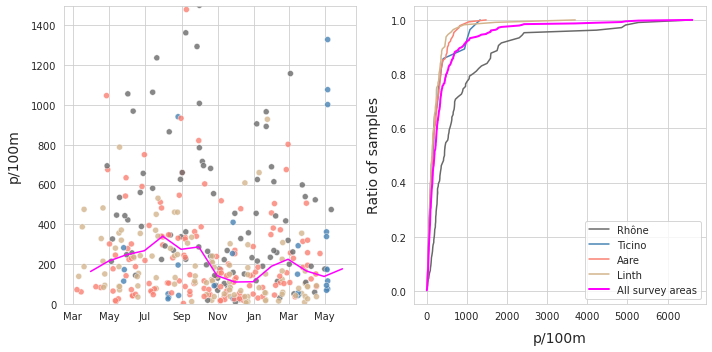
Fig. 1.4 ¶
Figure 1.4: Left; All survey totals from 2020-03 through 2021-05 grouped by survey area and aggregated to the monthly median. Values greater than 2324.3p/100m are not shown. Right: The empirical cumulative distribution of the survey totals.
Summary data and material types
# get the basic statistics from pd.describe
cs = dt_all[unit_label].describe().round(2)
# add project totals
cs["total objects"] = dt_all.quantity.sum()
# change the names
csx = sut.change_series_index_labels(cs, sut.create_summary_table_index(unit_label, lang="EN"))
combined_summary = sut.fmt_combined_summary(csx, nf=[])
fd_mat_totals = sut.the_ratio_object_to_total(code_totals)
fd_mat_totals = sut.fmt_pct_of_total(fd_mat_totals)
fd_mat_totals = sut.make_string_format(fd_mat_totals)
# applly new column names for printing
cols_to_use = {"material":"Material","quantity":"Quantity", "% of total":"% of total"}
fd_mat_t = fd_mat_totals[cols_to_use.keys()].values
# make tables
fig, axs = plt.subplots(1,2, figsize=(8,6))
# summary table
# names for the table columns
a_col = ["All survey areas", "total"]
axone = axs[0]
sut.hide_spines_ticks_grids(axone)
table_two = sut.make_a_table(axone, combined_summary, colLabels=a_col, colWidths=[.5,.25,.25], bbox=[0,0,1,1], **{"loc":"lower center"})
table_two.get_celld()[(0,0)].get_text().set_text(" ")
table_two.set_fontsize(14)
# material table
axtwo = axs[1]
axtwo.set_xlabel(" ")
sut.hide_spines_ticks_grids(axtwo)
table_three = sut.make_a_table(axtwo, fd_mat_t, colLabels=list(cols_to_use.values()), colWidths=[.4, .3,.3], bbox=[0,0,1,1], **{"loc":"lower center"})
table_three.get_celld()[(0,0)].get_text().set_text(" ")
table_three.set_fontsize(14)
plt.tight_layout()
glue("summarymaterial", fig, display=False)
plt.close()
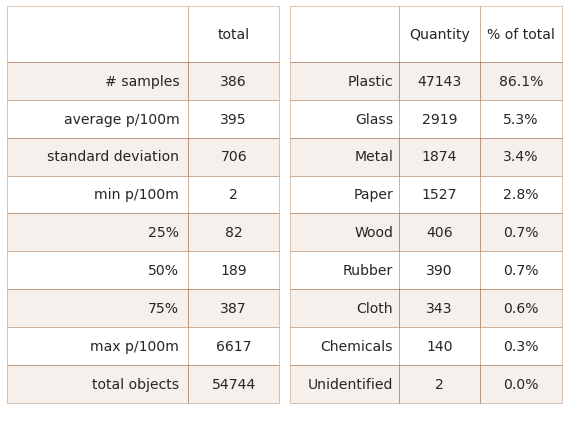
Fig. 1.5 ¶
Figure 1.5: Left: Summary of survey totals for all survey areas. Right: Material type and percent of total for all survey areas.
1.4. The most common objects¶
The most common objects are the ten most abundant by quantity AND/OR objects identified in at least 50% of all surveys.
# the top ten by quantity
most_abundant = code_totals.sort_values(by="quantity", ascending=False)[:10]
# the most common
most_common = code_totals[code_totals["fail rate"] >= a_fail_rate ].sort_values(by="quantity", ascending=False)
# merge with most_common and drop duplicates
m_common = pd.concat([most_abundant, most_common]).drop_duplicates()
# get percent of total
m_common_percent_of_total = m_common.quantity.sum()/code_totals.quantity.sum()
# format values for table
m_common["item"] = m_common.index.map(lambda x: code_description_map.loc[x])
m_common["% of total"] = m_common["% of total"].map(lambda x: F"{x}%")
m_common["quantity"] = m_common.quantity.map(lambda x: "{:,}".format(x))
m_common["fail rate"] = m_common["fail rate"].map(lambda x: F"{x}%")
m_common[unit_label] = m_common[unit_label].map(lambda x: F"{np.ceil(x)}")
# final table data
cols_to_use = {"item":"Item","quantity":"quantity", "% of total":"% of total", "fail rate":"fail rate", unit_label:unit_label}
all_survey_areas = m_common[cols_to_use.keys()].values
fig, axs = plt.subplots(figsize=(9,len(m_common)*.6))
sut.hide_spines_ticks_grids(axs)
table_four = sut.make_a_table(axs, all_survey_areas, colLabels=list(cols_to_use.values()), colWidths=[.52, .12,.12,.12, .12], bbox=[0,0,1,1], **{"loc":"lower center"})
table_four.get_celld()[(0,0)].get_text().set_text(" ")
table_four.set_fontsize(14)
plt.tight_layout()
glue("mcommoneos", fig, display=False)
plt.close()
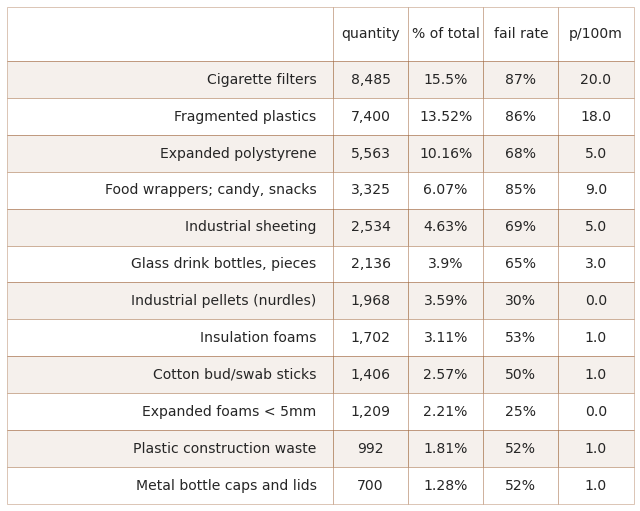
Fig. 1.6 ¶
Figure 1.6: The most common objects for all survey areas. The fail rate is the number of times an object was identified with respect to the number of surveys. Combined, the most common objects represent 68% of total objects found.
Most common objects median p/100m by survey area
# aggregated survey totals for the most common codes for all the survey areas
# aggregate the code totals by survey and then get the median value per survey
m_common_st = fd[fd.code.isin(m_common.index)].groupby([this_level, "loc_date","code"], as_index=False).agg(agg_pcs_quantity)
m_common_ft = m_common_st.groupby([this_level, "code"], as_index=False)[unit_label].median()
# proper name of water feature for display
m_common_ft["f_name"] = m_common_ft[this_level].map(lambda x: comp_labels[x])
# map the desctiption to the code
m_common_ft["item"] = m_common_ft.code.map(lambda x: code_description_map.loc[x])
# pivot that
m_c_p = m_common_ft[["item", unit_label, "f_name"]].pivot(columns="f_name", index="item")
# quash the hierarchal column index
m_c_p.columns = m_c_p.columns.get_level_values(1)
# the aggregated totals of all the data
a_s_a = fd[fd.code.isin(m_common.index)].groupby(["water_name_slug", "loc_date", "code"], as_index=False).agg(agg_pcs_quantity)
a_s_a_cols = sut.aggregate_to_code(a_s_a, code_description_map,name=top_name[0])
ad_t_ten = pd.concat([m_c_p, a_s_a_cols], axis=1).sort_values(by=top_name[0], ascending=False)
# chart that
fig, ax = plt.subplots(figsize=(len(ad_t_ten.columns)*.9,len(ad_t_ten)*.9))
axone = ax
sns.heatmap(ad_t_ten, ax=axone, cmap=cmap2, annot=True, annot_kws={"fontsize":12}, fmt=".1f", square=True, cbar=False, linewidth=.1, linecolor="white")
axone.set_xlabel("")
axone.set_ylabel("")
axone.tick_params(labelsize=14, which="both", axis="both")
plt.setp(axone.get_xticklabels(), rotation=90)
glue("mcommonpcs", fig, display=False)
plt.close()
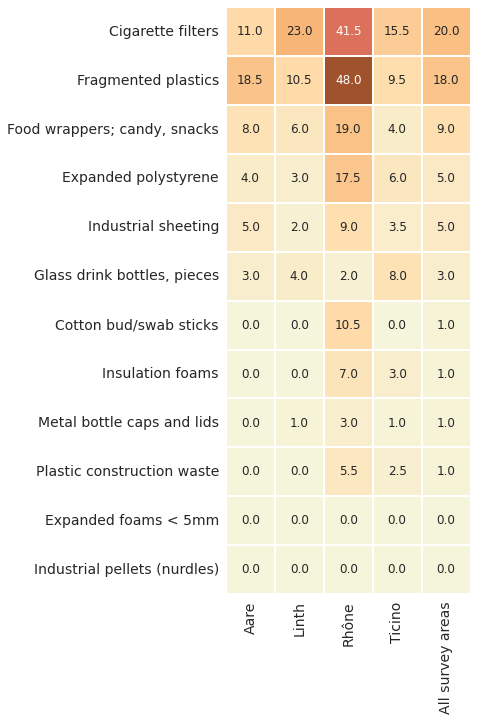
Fig. 1.7 ¶
Figure 1.7: The median p/100m of the most common objects for all survey areas. The rates at which the most common objects are identified are different for each survey area.
Most common objects monthly average
# collect the survey results of the most common objects
m_common_m = fd[(fd.code.isin(m_common.index))].groupby(["loc_date","date","code", "groupname"], as_index=False).agg(agg_pcs_quantity)
m_common_m["date"] = pd.to_datetime(m_common_m["date"], format="%Y-%m-%d")
m_common_m.set_index("date", inplace=True)
# set the order of the chart, group the codes by groupname columns
an_order = m_common_m.groupby(["code","groupname"], as_index=False).quantity.sum().sort_values(by="groupname")["code"].values
# a manager dict for the monthly results of each code
mgr = {}
# get the monhtly results for each code:
for a_group in an_order:
# resample by month
a_plot = m_common_m[(m_common_m.code==a_group)][unit_label].resample("M").mean().fillna(0)
this_group = {a_group:a_plot}
mgr.update(this_group)
months={
0:"Jan",
1:"Feb",
2:"Mar",
3:"Apr",
4:"May",
5:"Jun",
6:"Jul",
7:"Aug",
8:"Sep",
9:"Oct",
10:"Nov",
11:"Dec"
}
# convenience function to lable x axis
def new_month(x):
if x <= 11:
this_month = x
else:
this_month=x-12
return this_month
fig, ax = plt.subplots(figsize=(9,7))
# define a bottom
bottom = [0]*len(mgr["G27"])
# the monhtly survey average for all objects and locations
monthly_fd = dt_all.copy()
monthly_fd.set_index("date", inplace=True)
m_fd = monthly_fd[unit_label].resample("M").mean().fillna(0)
# define the xaxis
this_x = [i for i,x in enumerate(m_fd.index)]
# plot the monthly total survey average
ax.bar(this_x, m_fd.to_numpy(), color=a_color, alpha=0.2, linewidth=1, edgecolor="teal", width=1, label="Monthly survey average")
# plot the monthly survey average of the most common objects
for i, a_group in enumerate(an_order):
# define the axis
this_x = [i for i,x in enumerate(mgr[a_group].index)]
# collect the month
this_month = [x.month for i,x in enumerate(mgr[a_group].index)]
# if i == 0 laydown the first bars
if i == 0:
ax.bar(this_x, mgr[a_group].to_numpy(), label=a_group, color=colors_palette[a_group], linewidth=1, alpha=0.6 )
# else use the previous results to define the bottom
else:
bottom += mgr[an_order[i-1]].to_numpy()
ax.bar(this_x, mgr[a_group].to_numpy(), bottom=bottom, label=a_group, color=colors_palette[a_group], linewidth=1, alpha=0.8)
# collect the handles and labels from the legend
handles, labels = ax.get_legend_handles_labels()
# set the location of the x ticks
ax.xaxis.set_major_locator(ticker.FixedLocator([i for i in np.arange(len(this_x))]))
ax.set_ylabel(unit_label, **ck.xlab_k14)
# label the xticks by month
axisticks = ax.get_xticks()
labelsx = [months[new_month(x-1)] for x in this_month]
plt.xticks(ticks=axisticks, labels=labelsx)
# make the legend
# swap out codes for descriptions
new_labels = [code_description_map.loc[x] for x in labels[1:]]
new_labels = new_labels[::-1]
# insert a label for the monthly average
new_labels.insert(0,"Monthly survey average")
handles = [handles[0], *handles[1:][::-1]]
ax.set_title("")
plt.legend(handles=handles, labels=new_labels, bbox_to_anchor=(.5, -.05), loc="upper center", ncol=2, fontsize=14)
glue("monthlyeos", fig, display=False)
plt.close()
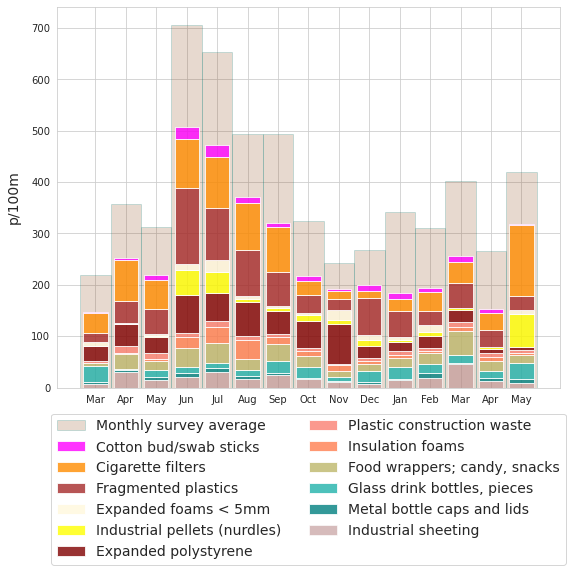
Fig. 1.8 ¶
Figure 1.8: Monthly average survey result as p/100m of the most common objects for all survey areas.
1.5. Survey results and land use¶
The survey results with respect to land use at the national level are discussed in detail in The land use profile and Shared responsibility.
1.6. Utility of the objects found¶
The utility type is based on the utilization of the object prior to it being discarded or item description if the original use is undetermined. Identified objects are classified into one of the predefined categories. The categories are grouped according to utilization or item description.
wastewater: items released from water treatment plants includes items likely toilet flushed
micro plastics (< 5mm): fragmented plastics and pre-production plastic resins
infrastructure: items related to construction and maintenance of buildings, roads and water/power supplies
food and drink: all materials related to consuming food and drink
agriculture: primarily industrial sheeting i.e., mulch and row covers, greenhouses, soil fumigation, bale wraps. Includes hard plastics for agricultural fencing, flowerpots etc.
tobacco: primarily cigarette filters, includes all smoking related material
recreation: objects related to sports and leisure i.e., fishing, hunting, hiking etc.
packaging non food and drink: packaging material not identified as food, drink nor tobacco related
plastic fragments: plastic pieces of undetermined origin or use
personal items: accessories, hygiene and clothing related
See the annex for the complete list of objects identified, includes descriptions and group classification. The section Code groups describes each code group in detail and provides a comprehensive list of all objects in a group.
All survey areas utility of objects found % of total by survey area. Fragmented objects with no clear identification remain classified by size:
# code groups aggregated by survey for each survey area
groups = ["loc_date","groupname"]
cg_t = fd.groupby([this_level,"loc_date", "groupname"], as_index=False).agg(agg_pcs_quantity)
# aggregate all that for each survey area
cg_t = cg_t.groupby([this_level, "groupname"], as_index=False).agg({unit_label:"median", "quantity":"sum", "loc_date":"nunique"})
# quantity per water survey area
cg_tq = cg_t.groupby(this_level).quantity.sum()
# assign survey area total to each record
for a_feature in cg_tq.index:
cg_t.loc[cg_t[this_level] == a_feature, "f_total"] = cg_tq.loc[a_feature]
# get the percent of total for each group for each survey area
cg_t["pt"] = (cg_t.quantity/cg_t.f_total).round(2)
# pivot that
data_table = cg_t.pivot(columns=this_level, index="groupname", values="pt")
data_table[top_name[0]] = sut.aggregate_to_group_name(fd, unit_label=unit_label, column="groupname", name=top_name[0], val="pt")
data_table.rename(columns={x:comp_labels[x] for x in data_table.columns[:-1]}, inplace=True)
fig, ax = plt.subplots(figsize=(10,10))
axone = ax
sns.heatmap(data_table , ax=axone, cmap=cmap2, annot=True, annot_kws={"fontsize":12}, cbar=False, fmt=".0%", linewidth=.1, square=True, linecolor="white")
axone.set_xlabel("")
axone.set_ylabel("")
axone.tick_params(labelsize=14, which="both", axis="both", labeltop=False, labelbottom=True)
plt.setp(axone.get_xticklabels(), rotation=90, fontsize=14)
plt.setp(axone.get_yticklabels(), rotation=0, fontsize=14)
glue("utility", fig, display=False)
plt.close()
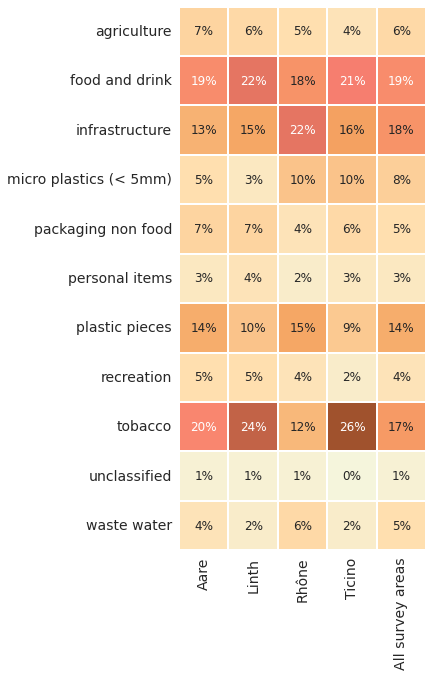
Fig. 1.9 ¶
Figure 1.9: The utility of objects as a % of total for all the survey areas.
# median p/50m solve cg_t for unit_label
data_table = cg_t.pivot(columns=this_level, index="groupname", values=unit_label)
# column for all the data
a = fd.groupby(["groupname", "loc_date"], as_index=False)[unit_label].sum()
a[top_name[0]] = a[unit_label]
a = a.groupby("groupname")[top_name[0]].median()
# stick that together
data = pd.concat([data_table, a], axis=1)
# format for display
data.rename(columns={x:comp_labels[x] for x in data.columns[:-1]}, inplace=True)
fig, ax = plt.subplots(figsize=(10,10))
axone = ax
sns.heatmap(data , ax=axone, cmap=cmap2, annot=True, annot_kws={"fontsize":12}, fmt="g", cbar=False, linewidth=.1, square=True, linecolor="white")
axone.set_xlabel("")
axone.set_ylabel("")
axone.tick_params(labelsize=14, which="both", axis="both", labeltop=False, labelbottom=True)
plt.setp(axone.get_xticklabels(), rotation=90, fontsize=14)
plt.setp(axone.get_yticklabels(), rotation=0, fontsize=14)
glue("utility2", fig, display=False)
plt.close()
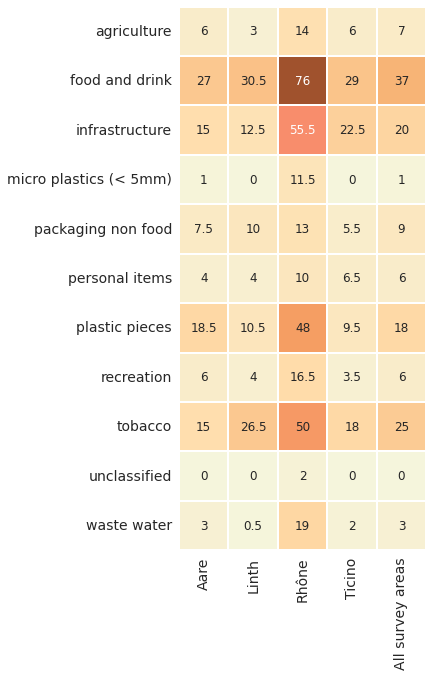
Fig. 1.10 ¶
Figure 1.10: The Rhône survey area has the highest median values for the most common objects. However, as a percentage of total, abundant items related to tobacco, food and drink are less than infrastructure related objects.
1.7. Rivers¶
rivers = fd[fd.w_t == "r"].copy()
r_smps = rivers.groupby(["loc_date", "date", "location", "water_name_slug"], as_index=False).agg(agg_pcs_quantity)
l_smps = fd[fd.w_t == "l"].groupby(["loc_date","date","location", "water_name_slug"], as_index=False).agg(agg_pcs_quantity)
cs = r_smps[unit_label].describe().round(2)
# add project totals
cs["total objects"] = r_smps.quantity.sum()
# change the names
csx = sut.change_series_index_labels(cs, sut.create_summary_table_index(unit_label, lang="EN"))
combined_summary = sut.fmt_combined_summary(csx, nf=[])
# make the charts
fig = plt.figure(figsize=(11,6))
aspec = fig.add_gridspec(ncols=11, nrows=3)
ax = fig.add_subplot(aspec[:, :6])
line_label = F"{rate} median:{top_name[0]}"
sns.scatterplot(data=l_smps, x="date", y=unit_label, color="black", alpha=0.4, label="Lake surveys", ax=ax)
sns.scatterplot(data=r_smps, x="date", y=unit_label, color="red", s=34, ec="white",label="River surveys", ax=ax)
ax.set_ylim(-10,y_limit)
ax.set_xlabel("")
ax.set_ylabel(unit_label, **ck.xlab_k14)
ax.xaxis.set_major_locator(months_loc)
ax.xaxis.set_major_formatter(months_fmt)
a_col = [top_name[0], "total"]
axone = fig.add_subplot(aspec[:, 7:])
sut.hide_spines_ticks_grids(axone)
table_five = sut.make_a_table(axone, combined_summary, colLabels=a_col, colWidths=[.5,.25,.25], bbox=[0,0,1,1], **{"loc":"lower center"})
table_five.get_celld()[(0,0)].get_text().set_text(" ")
table_five.set_fontsize(14)
glue("rivers", fig, display=False)
plt.close()
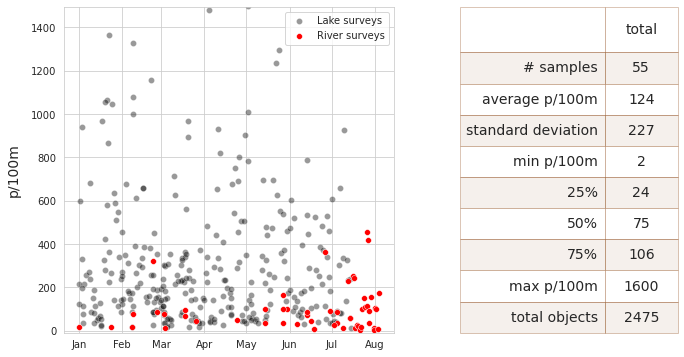
Fig. 1.11 ¶
Figure 1.11: Left: All survey areas river survey totals, 2020-03 through 2021-05, n=55. Values greater than 2324.3p/100m 98% not shown. Right: Summary data.
Most common objects
# the most common items rivers
r_codes = rivers.groupby("code").agg({"quantity":"sum", "fail":"sum", unit_label:"median"})
r_codes["fail rate"] = (r_codes.fail/r_smps.loc_date.nunique()*100).round(2)
# top ten
r_byq = r_codes.sort_values(by="quantity", ascending=False)[:10]
# most common
r_byfail = r_codes[r_codes["fail rate"] >= a_fail_rate]
r_common = list(set(r_byq) | set(r_byfail))
r_mc = pd.concat([r_byfail, r_byq]).drop_duplicates()
# format for display
r_mc["item"] = r_mc.index.map(lambda x: code_description_map.loc[x])
r_mc.sort_values(by="quantity", ascending=False, inplace=True)
r_mc["% of total"]=((r_mc.quantity/r_codes.quantity.sum())*100).round(2)
r_mc["% of total"] = r_mc["% of total"].map(lambda x: F"{x}%")
r_mc["quantity"] = r_mc.quantity.map(lambda x: "{:,}".format(x))
r_mc["fail rate"] = r_mc["fail rate"].map(lambda x: F"{x}%")
r_mc[unit_label] = r_mc[unit_label].map(lambda x: F"{np.ceil(x)}")
cols_to_use = {"item":"Item","quantity":"Quantity"}
r_mc.rename(columns=cols_to_use, inplace=True)
data=r_mc[["Item","Quantity", "% of total", "fail rate", unit_label]]
fig, axs = plt.subplots(figsize=(11,len(data)*.6))
sut.hide_spines_ticks_grids(axs)
table_six = sut.make_a_table(axs, data.values, colLabels=data.columns, colWidths=[.52, .12,.12,.12, .12], bbox=[0,0,1,1], **{"loc":"lower center"})
table_six.get_celld()[(0,0)].get_text().set_text(" ")
table_six.set_fontsize(14)
plt.tight_layout()
glue("rivers2", fig, display=False)
plt.close()
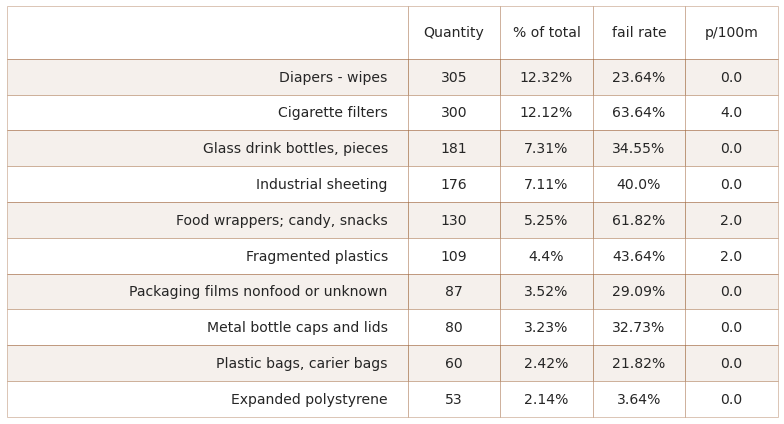
Fig. 1.12 ¶
Figure 1.12: The most common objects from river surveys. Diapers - wipes and plastic bags are not present in the most common objects when lakes are considered.
1.8. Annex¶
1.8.1. Fragmented foams and plastics by size group¶
These are the components of Gfoam and Gfrags, objects labled “Expanded foams” are grouped with Gfoam the rest are grouped under Gfrags.
All survey areas fragmented plastics and foamed plastics by size, median p/100m, number of pieces, and percent of total.
# collect the data before aggregating foams for all locations in the survye area
# group by loc_date and code
# Combine the different sizes of fragmented plastics and styrofoam
# the codes for the foams
some_foams = ["G81", "G82", "G83", "G74"]
# the codes for the fragmented plastics
some_frag_plas = list(before_agg[before_agg.groupname == "plastic pieces"].code.unique())
fd_frags_foams = before_agg[(before_agg.code.isin([*some_frag_plas, *some_foams]))&(before_agg.location.isin(fd.location.unique()))].groupby(["loc_date","code"], as_index=False).agg(agg_pcs_quantity)
fd_frags_foams = fd_frags_foams.groupby("code").agg({unit_label:"median", "quantity":"sum"})
# add code description and format for printing
fd_frags_foams["item"] = fd_frags_foams.index.map(lambda x: code_description_map.loc[x])
fd_frags_foams["% of total"] = (fd_frags_foams.quantity/fd.quantity.sum()*100).round(2)
fd_frags_foams["% of total"] = fd_frags_foams["% of total"].map(lambda x: F"{x}%")
fd_frags_foams["quantity"] = fd_frags_foams["quantity"].map(lambda x: F"{x:,}")
# table data
data = fd_frags_foams[["item",unit_label, "quantity", "% of total"]]
fig, axs = plt.subplots(figsize=(len(data.columns)*2.1,len(data)*.6))
sut.hide_spines_ticks_grids(axs)
table_seven = sut.make_a_table(axs, data.values, colLabels=data.columns, colWidths=[.6, .13, .13, .13],a_color=a_color)
table_seven.get_celld()[(0,0)].get_text().set_text(" ")
table_seven.set_fontsize(14)
plt.tight_layout()
plt.show()
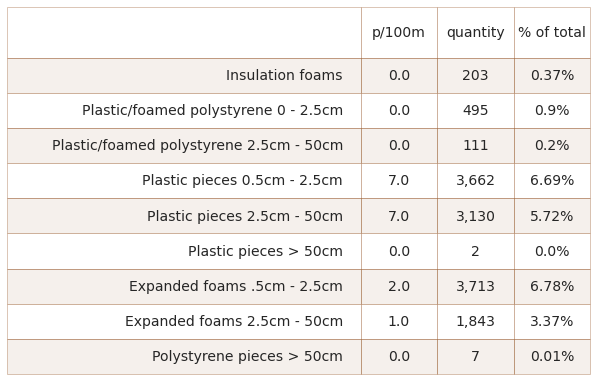
1.8.2. Organizations:¶
Precious Plastic Léman
Association pour la Sauvegarde du Léman
Geneva international School
Solid waste engineering: École polytechnique fédéral Lausanne
Summit foundation
University of Raperswill
Hackuarium
1.8.3. Municipalities, lakes and rivers with surveys¶
lakes = dfBeaches.loc[(dfBeaches.index.isin(fd.location.unique()))&(dfBeaches.water == "l")]["water_name"].unique()
rivers = dfBeaches.loc[(dfBeaches.index.isin(fd.location.unique()))&(dfBeaches.water == "r")]["water_name"].unique()
# gather the municpalities and the population:
fd_pop_map = dfBeaches.loc[fd.location.unique()][["city","population"]].copy()
fd_pop_map.drop_duplicates(inplace=True)
fd_pop_map.set_index("city", drop=True, inplace=True)
munis_joined = ", ".join(sorted(fd_pop_map.index))
muni_string = F"""**The municipalities in this report:**\n\n >{munis_joined}
"""
md(muni_string)
The municipalities in this report:
Aarau, Allaman, Ascona, Beatenberg, Bellinzona, Bern, Biel/Bienne, Boudry, Bourg-en-Lavaux, Brienz (BE), Brissago, Brugg, Brügg, Burgdorf, Bönigen, Cheyres-Châbles, Cudrefin, Dietikon, Erlach, Estavayer, Freienbach, Gals, Gambarogno, Gebenstorf, Genève, Gland, Glarus Nord, Grandson, Hauterive (NE), Hünenberg, Kallnach, Köniz, Küsnacht (ZH), La Tour-de-Peilz, Lausanne, Lavey-Morcles, Le Landeron, Leuk, Ligerz, Locarno, Lugano, Luterbach, Lüscherz, Merenschwand, Minusio, Montreux, Neuchâtel, Nidau, Port, Préverenges, Quarten, Rapperswil-Jona, Richterswil, Riddes, Rubigen, Saint-Gingolph, Saint-Sulpice (VD), Salgesch, Schmerikon, Sion, Solothurn, Spiez, Stäfa, Thun, Tolochenaz, Unterengstringen, Unterseen, Versoix, Vevey, Vinelz, Walenstadt, Walperswil, Weesen, Weggis, Yverdon-les-Bains, Zug, Zürich
lakes_joined = ", ".join(sorted(lakes))
lake_string = F"""**The lakes in this report:**\n\n >{lakes_joined}
"""
md(lake_string)
The lakes in this report:
Bielersee, Brienzersee, Lac Léman, Lago Maggiore, Lago di Lugano, Neuenburgersee, Quatre Cantons, Thunersee, Walensee, Zugersee, Zurichsee
The rivers in this report:
Aare, Aare|Nidau-Büren-Kanal, Cassarate, Dorfbach, Emme, Escherkanal, Jona, La Thièle, Limmat, Linthkanal, Maggia, Reuss, Rhône, Schüss, Seez, Sihl, Ticino
# summary statistics:
# number of samples
fd_n_samps = len(dt_all)
# quantity
fd_n_obj = fd.quantity.sum()
# number of locations
fd_n_locs = fd.location.nunique()
# number of cities
fd_n_munis = len(fd_pop_map.index)
# populations
fd_effected_population = fd_pop_map.sum()
# list of locations
fd_locs = fd.location.unique()
# list of survey keys
fd_samps = fd.loc_date.unique()
obj_string = "{:,}".format(fd_n_obj)
surv_string = "{:,}".format(fd_n_samps)
pop_string = "{:,}".format(int(fd_effected_population[0]))
date_quantity_context = F"For the period between {start_date[:-3]} and {end_date[:-3]}, {obj_string } objects were removed and identified in the course of {surv_string} surveys."
geo_context = F"Those surveys were conducted at {fd_n_locs} different locations."
admin_context = F"There are {fd_n_munis} different municipalities represented in these results with a combined population of approximately {pop_string}."
md(F"{date_quantity_context} {geo_context } {admin_context}")
For the period between 2020-03 and 2021-05, 54,744 objects were removed and identified in the course of 386 surveys. Those surveys were conducted at 143 different locations. There are 77 different municipalities represented in these results with a combined population of approximately 1,735,991.
The survey locations
# display the survey locations
pd.set_option("display.max_rows", None)
disp_columns = ["latitude", "longitude", "city"]
disp_beaches = dfBeaches.loc[fd_locs][disp_columns]
disp_beaches.reset_index(inplace=True)
disp_beaches.rename(columns={"slug":"location"}, inplace=True)
disp_beaches.set_index("location", inplace=True, drop=True)
disp_beaches
| latitude | longitude | city | |
|---|---|---|---|
| location | |||
| maladaire | 46.446296 | 6.876960 | La Tour-de-Peilz |
| preverenges | 46.512690 | 6.527657 | Préverenges |
| caprino | 45.987963 | 8.986241 | Lugano |
| foce-del-cassarate | 46.002411 | 8.961477 | Lugano |
| lido | 46.002004 | 8.962156 | Lugano |
| lugano-centro | 46.002627 | 8.950724 | Lugano |
| spiaggia-parco-ciani | 46.002510 | 8.960820 | Lugano |
| via-brunari-spiaggia | 46.202350 | 9.016910 | Bellinzona |
| golene-gudo | 46.170655 | 8.946657 | Bellinzona |
| isole-di-brissago-porto | 46.132760 | 8.735030 | Brissago |
| magadino-lido | 46.149349 | 8.855663 | Gambarogno |
| rivapiana | 46.172079 | 8.813255 | Minusio |
| via-mirasole-spiaggia | 46.199530 | 9.014930 | Bellinzona |
| aare-port | 47.116170 | 7.269550 | Port |
| limmat_dietikon_keiserp | 47.407989 | 8.409540 | Dietikon |
| schutzenmatte | 47.057666 | 7.634001 | Burgdorf |
| zugerseecholler_cham_blarerm | 47.178216 | 8.480013 | Zug |
| la-petite-plage | 46.785054 | 6.656877 | Yverdon-les-Bains |
| vidy-ruines | 46.516221 | 6.596279 | Lausanne |
| baby-plage-geneva | 46.208558 | 6.162923 | Genève |
| grand-clos | 46.387746 | 6.843686 | Saint-Gingolph |
| weissenau-neuhaus | 46.676583 | 7.817528 | Unterseen |
| evole-plage | 46.989477 | 6.923920 | Neuchâtel |
| oberi-chlihochstetten | 46.896025 | 7.532114 | Rubigen |
| plage-de-serriere | 46.984850 | 6.913450 | Neuchâtel |
| vierwaldstattersee_weggis_schoberls_1 | 47.044532 | 8.418569 | Weggis |
| vierwaldstattersee_weggis_schoberls_2 | 47.043953 | 8.417308 | Weggis |
| vierwaldstattersee_weggis_schoberls_3 | 47.029957 | 8.410801 | Weggis |
| mullermatte | 47.133339 | 7.227907 | Biel/Bienne |
| limmat_unterengstringen_oggierbuhrer | 47.409400 | 8.446933 | Unterengstringen |
| limmat_zuerich_wagnerc | 47.403496 | 8.477770 | Zürich |
| limmat_zurich_mortensena_meiera | 47.400252 | 8.485411 | Zürich |
| quai-maria-belgia | 46.460156 | 6.836718 | Vevey |
| sihl_zuerich_eggerskoehlingera | 47.381898 | 8.538328 | Zürich |
| bielersee_vinelz_fankhausers | 47.038398 | 7.108311 | Vinelz |
| erlach-camping-strand | 47.047159 | 7.097854 | Erlach |
| anarchy-beach | 46.447216 | 6.859612 | La Tour-de-Peilz |
| gasi-strand | 47.128442 | 9.110831 | Weesen |
| rastplatz-stampf | 47.215177 | 8.844286 | Rapperswil-Jona |
| zuerichsee_richterswil_benkoem_2 | 47.217646 | 8.698713 | Richterswil |
| sentiero-giro-del-golf-spiaggia | 46.145770 | 8.790430 | Ascona |
| vira-gambarogno | 46.143343 | 8.838759 | Gambarogno |
| canale-saleggi | 46.200625 | 9.015853 | Bellinzona |
| gummligrabbe | 46.989290 | 7.250730 | Kallnach |
| mannewil | 46.996382 | 7.239024 | Kallnach |
| lavey-les-bains-2 | 46.207726 | 7.011685 | Lavey-Morcles |
| schusspark-strand | 47.146500 | 7.268620 | Biel/Bienne |
| walensee_walenstadt_wysse | 47.121828 | 9.299552 | Walenstadt |
| pfafikon-bad | 47.206766 | 8.774182 | Freienbach |
| zurichsee_kusnachterhorn_thirkell-whitej | 47.317685 | 8.576860 | Küsnacht (ZH) |
| plage-de-cheyres | 46.818689 | 6.782256 | Cheyres-Châbles |
| leuk-mattenstrasse | 46.314754 | 7.622521 | Leuk |
| thun-strandbad | 46.739939 | 7.633520 | Thun |
| zurichsee_wollishofen_langendorfm | 47.345890 | 8.536155 | Zürich |
| pont-sous-terre | 46.202960 | 6.131577 | Genève |
| oben-am-see | 46.744451 | 8.049921 | Brienz (BE) |
| thunersee_spiez_meierd_1 | 46.704437 | 7.657882 | Spiez |
| cully-plage | 46.488887 | 6.741396 | Bourg-en-Lavaux |
| preverenges-le-sout | 46.508905 | 6.534526 | Préverenges |
| la-pecherie | 46.463919 | 6.385732 | Allaman |
| villa-barton | 46.222350 | 6.152500 | Genève |
| untertenzen | 47.115260 | 9.254780 | Quarten |
| zurcher-strand | 47.364200 | 8.537420 | Zürich |
| oyonne | 46.456682 | 6.852262 | La Tour-de-Peilz |
| lavey-la-source | 46.200804 | 7.021866 | Lavey-Morcles |
| lavey-les-bains | 46.205159 | 7.012722 | Lavey-Morcles |
| spackmatt | 47.223749 | 7.576711 | Luterbach |
| luscherz-plage | 47.047955 | 7.151242 | Lüscherz |
| strandboden-biel | 47.132510 | 7.233142 | Biel/Bienne |
| jona-river-rastplatz | 47.216100 | 8.844430 | Rapperswil-Jona |
| reuss_hunenberg_eberhardy | 47.232976 | 8.401012 | Hünenberg |
| reuss_ottenbach_schoenenbergerl | 47.278354 | 8.394224 | Merenschwand |
| zuerichsee_staefa_hennm | 47.234643 | 8.769881 | Stäfa |
| signalpain | 46.786200 | 6.647360 | Yverdon-les-Bains |
| baby-plage-ii-geneve | 46.208940 | 6.164330 | Genève |
| pointe-dareuse | 46.946190 | 6.870970 | Boudry |
| les-glariers | 46.176736 | 7.228925 | Riddes |
| nidau-strand | 47.127196 | 7.232613 | Nidau |
| tiger-duck-beach | 46.518256 | 6.582546 | Saint-Sulpice (VD) |
| linthdammweg | 47.131790 | 9.091910 | Weesen |
| mols-rocks | 47.114343 | 9.288174 | Quarten |
| seeflechsen | 47.130223 | 9.103400 | Glarus Nord |
| seemuhlestrasse-strand | 47.128640 | 9.295100 | Walenstadt |
| muhlehorn-dorf | 47.118448 | 9.172124 | Glarus Nord |
| zuerichsee_waedenswil_colomboc_1 | 47.219547 | 8.691961 | Richterswil |
| camp-des-peches | 47.052812 | 7.074053 | Le Landeron |
| delta-park | 46.720078 | 7.635304 | Spiez |
| le-pierrier | 46.439727 | 6.888968 | Montreux |
| pecos-plage | 46.803590 | 6.636650 | Grandson |
| beich | 47.048495 | 7.200528 | Walperswil |
| aare_suhrespitz_badert | 47.405669 | 8.066018 | Aarau |
| tschilljus | 46.304399 | 7.580262 | Salgesch |
| sundbach-strand | 46.684386 | 7.794768 | Beatenberg |
| wycheley | 46.740370 | 8.048640 | Brienz (BE) |
| aare_koniz_hoppej | 46.934588 | 7.458170 | Köniz |
| camping-gwatt-strand | 46.727140 | 7.629620 | Thun |
| bern-tiergarten | 46.933157 | 7.452004 | Bern |
| boiron | 46.491030 | 6.480162 | Tolochenaz |
| rocky-plage | 46.209737 | 6.164952 | Genève |
| lacleman_gland_lecoanets | 46.402811 | 6.281959 | Gland |
| route-13 | 46.162521 | 8.782579 | Locarno |
| murg-bad | 47.115307 | 9.215691 | Quarten |
| schmerikon-bahnhof-strand | 47.224780 | 8.944180 | Schmerikon |
| aabach | 47.220989 | 8.940365 | Schmerikon |
| la-thiele_le-mujon_confluence | 46.775340 | 6.630900 | Yverdon-les-Bains |
| nouvelle-plage | 46.856646 | 6.848428 | Estavayer |
| baye-de-montreux-g | 46.430834 | 6.908778 | Montreux |
| les-vieux-ronquoz | 46.222049 | 7.361664 | Sion |
| sihl_zuerich_eichenbergerd | 47.339588 | 8.516697 | Zürich |
| versoix | 46.289194 | 6.170569 | Versoix |
| augustmutzenbergstrandweg | 46.686640 | 7.689760 | Spiez |
| parc-des-pierrettes | 46.515215 | 6.575531 | Saint-Sulpice (VD) |
| plage-de-st-sulpice | 46.513265 | 6.570977 | Saint-Sulpice (VD) |
| aare_bern_gerberm | 46.989363 | 7.452098 | Bern |
| brugg-be-buren-bsg-standort | 47.122220 | 7.281410 | Brügg |
| kusnachter-dorfbach-tobelweg-1-4 | 47.317770 | 8.588258 | Küsnacht (ZH) |
| ruisseau-de-la-croix-plage | 46.813920 | 6.774700 | Cheyres-Châbles |
| ligerz-strand | 47.083979 | 7.135894 | Ligerz |
| hafeli | 46.690283 | 7.898592 | Bönigen |
| aare-solothurn-lido-strand | 47.196949 | 7.521643 | Solothurn |
| bern-fahrstrasse | 46.975866 | 7.444210 | Bern |
| gals-reserve | 47.046272 | 7.085007 | Gals |
| ascona-traghetto-spiaggia | 46.153882 | 8.768480 | Ascona |
| pacha-mama-gerra | 46.123473 | 8.783508 | Gambarogno |
| gerra-gambarogno | 46.123366 | 8.785786 | Gambarogno |
| san-nazzaro-gambarogno | 46.130443 | 8.798657 | Gambarogno |
| hauterive-petite-plage | 47.010797 | 6.980304 | Hauterive (NE) |
| flibach-river-right-bank | 47.133742 | 9.105461 | Weesen |
| aare-limmatspitz | 47.501060 | 8.237371 | Gebenstorf |
| aare_brugg_buchie | 47.494855 | 8.236558 | Brugg |
| linth_route9brucke | 47.125730 | 9.117340 | Glarus Nord |
| seez_spennwiesenbrucke | 47.114948 | 9.310123 | Walenstadt |
| bain-des-dames | 46.450507 | 6.858092 | La Tour-de-Peilz |
| luscherz-two | 47.047519 | 7.152829 | Lüscherz |
| impromptu_cudrefin | 46.964496 | 7.027936 | Cudrefin |
| vira-spiaggia-left-of-river | 46.142900 | 8.838407 | Gambarogno |
| linth_mollis | 47.131370 | 9.094768 | Glarus Nord |
| seez | 47.119830 | 9.300251 | Walenstadt |
| tolochenaz | 46.497509 | 6.482875 | Tolochenaz |
| limmat_zuerich_suterdglauserp | 47.394539 | 8.513443 | Zürich |
| aare_post | 47.116665 | 7.271953 | Port |
| aare_bern_scheurerk | 46.970967 | 7.452586 | Bern |
| strandbeiz | 47.215862 | 8.843098 | Rapperswil-Jona |
The inventory
complete_inventory = code_totals[code_totals.quantity>0][["item", "groupname", "quantity", "% of total","fail rate"]]
complete_inventory.sort_values(by="quantity", ascending=False)
| item | groupname | quantity | % of total | fail rate | |
|---|---|---|---|---|---|
| code | |||||
| G27 | Cigarette filters | tobacco | 8485 | 15.50 | 87 |
| Gfrags | Fragmented plastics | plastic pieces | 7400 | 13.52 | 86 |
| Gfoam | Expanded polystyrene | infrastructure | 5563 | 10.16 | 68 |
| G30 | Food wrappers; candy, snacks | food and drink | 3325 | 6.07 | 85 |
| G67 | Industrial sheeting | agriculture | 2534 | 4.63 | 69 |
| G200 | Glass drink bottles, pieces | food and drink | 2136 | 3.90 | 65 |
| G112 | Industrial pellets (nurdles) | micro plastics (< 5mm) | 1968 | 3.59 | 30 |
| G74 | Insulation foams | infrastructure | 1702 | 3.11 | 53 |
| G95 | Cotton bud/swab sticks | waste water | 1406 | 2.57 | 50 |
| G117 | Expanded foams < 5mm | micro plastics (< 5mm) | 1209 | 2.21 | 25 |
| G89 | Plastic construction waste | infrastructure | 992 | 1.81 | 52 |
| G941 | Packaging films nonfood or unknown | packaging non food | 894 | 1.63 | 38 |
| G178 | Metal bottle caps and lids | food and drink | 700 | 1.28 | 52 |
| G25 | Tobacco; plastic packaging, containers | tobacco | 649 | 1.19 | 46 |
| G21 | Drink lids | food and drink | 623 | 1.14 | 37 |
| G106 | Plastic fragments angular <5mm | micro plastics (< 5mm) | 592 | 1.08 | 20 |
| G98 | Diapers - wipes | waste water | 588 | 1.07 | 26 |
| G24 | Plastic lid rings | food and drink | 541 | 0.99 | 42 |
| G177 | Foil wrappers, aluminum foil | food and drink | 521 | 0.95 | 47 |
| G10 | Food containers single use foamed or plastic | food and drink | 448 | 0.82 | 31 |
| G23 | Lids unidentified | packaging non food | 423 | 0.77 | 35 |
| G156 | Paper fragments | packaging non food | 420 | 0.77 | 32 |
| G35 | Straws and stirrers | food and drink | 419 | 0.77 | 42 |
| G70 | Shotgun cartridges | recreation | 391 | 0.71 | 21 |
| G31 | Lollypop sticks | food and drink | 381 | 0.70 | 37 |
| G73 | Foamed items & pieces (non packaging/insulatio... | recreation | 335 | 0.61 | 23 |
| G33 | Lids for togo drinks plastic | food and drink | 328 | 0.60 | 34 |
| G32 | Toys and party favors | recreation | 320 | 0.58 | 38 |
| G904 | Plastic fireworks | recreation | 301 | 0.55 | 28 |
| G3 | Plastic bags, carier bags | packaging non food | 285 | 0.52 | 18 |
| G22 | Lids for chemicals, detergents (non-food) | infrastructure | 257 | 0.47 | 19 |
| G211 | Swabs, bandaging, medical | personal items | 256 | 0.47 | 31 |
| G922 | Labels, bar codes | packaging non food | 252 | 0.46 | 27 |
| G66 | Straps/bands; hard, plastic package fastener | infrastructure | 248 | 0.45 | 32 |
| G100 | Medical; containers/tubes/ packaging | waste water | 244 | 0.45 | 28 |
| G923 | Tissue, toilet paper, napkins, paper towels | personal items | 241 | 0.44 | 25 |
| G103 | Plastic fragments rounded <5mm | micro plastics (< 5mm) | 238 | 0.43 | 3 |
| G921 | Ceramic tile and pieces | infrastructure | 231 | 0.42 | 13 |
| G96 | Sanitary-pads/tampons, applicators | waste water | 215 | 0.39 | 18 |
| G50 | String < 1cm | recreation | 205 | 0.37 | 29 |
| G153 | Cups, food containers, wrappers (paper) | food and drink | 201 | 0.37 | 19 |
| G125 | Balloons and balloon sticks | recreation | 170 | 0.31 | 20 |
| G91 | Biomass holder | waste water | 162 | 0.30 | 19 |
| G159 | Corks | food and drink | 162 | 0.30 | 21 |
| G38 | Coverings; plastic packaging, sheeting for pro... | unclassified | 160 | 0.29 | 4 |
| G940 | Foamed EVA for crafts and sports | recreation | 158 | 0.29 | 7 |
| G208 | Glass or ceramic fragments > 2.5 cm | unclassified | 145 | 0.26 | 10 |
| G186 | Industrial scrap | infrastructure | 141 | 0.26 | 15 |
| G213 | Paraffin wax | recreation | 138 | 0.25 | 13 |
| G165 | Ice cream sticks, toothpicks, chopsticks | food and drink | 126 | 0.23 | 15 |
| G204 | Bricks, pipes not plastic | infrastructure | 125 | 0.23 | 9 |
| G155 | Fireworks paper tubes and fragments | recreation | 124 | 0.23 | 6 |
| G93 | Cable ties; steggel, zip, zap straps | infrastructure | 121 | 0.22 | 16 |
| G149 | Paper packaging | packaging non food | 121 | 0.22 | 8 |
| G152 | Cigarette boxes, tobacco related paper/cardboard | tobacco | 120 | 0.22 | 13 |
| G90 | Plastic flower pots | agriculture | 119 | 0.22 | 14 |
| G137 | Clothing, towels & rags | personal items | 118 | 0.22 | 13 |
| G908 | Tape; electrical, insulating | infrastructure | 117 | 0.21 | 15 |
| G203 | Tableware ceramic or glass, cups, plates, pieces | food and drink | 115 | 0.21 | 11 |
| G936 | Sheeting ag. greenhouse film | agriculture | 110 | 0.20 | 12 |
| G34 | Cutlery, plates and trays | food and drink | 109 | 0.20 | 16 |
| G905 | Hair clip, hair ties, personal accessories pl... | personal items | 105 | 0.19 | 18 |
| G198 | Other metal pieces < 50cm | infrastructure | 104 | 0.19 | 16 |
| G914 | Paperclips, clothespins, plastic utility items | personal items | 99 | 0.18 | 12 |
| G131 | Rubber bands | personal items | 94 | 0.17 | 16 |
| G191 | Wire and mesh | agriculture | 90 | 0.16 | 12 |
| G28 | Pens, lids, mechanical pencils etc. | personal items | 88 | 0.16 | 13 |
| G115 | Foamed plastic <5mm | micro plastics (< 5mm) | 88 | 0.16 | 4 |
| G124 | Other plastic or foam products | unclassified | 87 | 0.16 | 8 |
| G87 | Tape, masking/duct/packing | infrastructure | 87 | 0.16 | 14 |
| G148 | Cardboard (boxes and fragments) | packaging non food | 85 | 0.16 | 8 |
| G928 | Ribbons and bows | personal items | 84 | 0.15 | 8 |
| G26 | Cigarette lighters | tobacco | 83 | 0.15 | 14 |
| G146 | Paper, cardboard | packaging non food | 82 | 0.15 | 6 |
| G175 | Cans, beverage | food and drink | 76 | 0.14 | 11 |
| G157 | Paper | packaging non food | 66 | 0.12 | 6 |
| G7 | Drink bottles < = 0.5L | food and drink | 65 | 0.12 | 9 |
| G4 | Small plastic bags; freezer, zip-lock etc. | packaging non food | 64 | 0.12 | 8 |
| G142 | Rope , string or nets | recreation | 62 | 0.11 | 10 |
| G135 | Clothes, footware, headware, gloves | personal items | 61 | 0.11 | 9 |
| G105 | Plastic fragments subangular <5mm | micro plastics (< 5mm) | 59 | 0.11 | 2 |
| G927 | String trimmer line, used to cut grass, weeds,... | infrastructure | 57 | 0.10 | 8 |
| G201 | Jars, includes pieces | food and drink | 55 | 0.10 | 7 |
| G942 | Plastic shavings from lathes, CNC machining | unclassified | 53 | 0.10 | 8 |
| G194 | Cables, metal wire(s) often inside rubber or p... | infrastructure | 52 | 0.09 | 10 |
| G939 | Flowers, plants plastic | personal items | 49 | 0.09 | 6 |
| G20 | Caps and lids | packaging non food | 48 | 0.09 | 6 |
| G65 | Buckets | agriculture | 48 | 0.09 | 6 |
| G943 | Fencing agriculture, plastic | agriculture | 47 | 0.09 | 5 |
| G144 | Tampons | waste water | 46 | 0.08 | 3 |
| G48 | Rope, synthetic | recreation | 46 | 0.08 | 8 |
| G134 | Other rubber | unclassified | 45 | 0.08 | 8 |
| G210 | Other glass/ceramic | unclassified | 43 | 0.08 | 3 |
| G170 | Wood (processed) | agriculture | 43 | 0.08 | 6 |
| G937 | Pheromone baits for vineyards | agriculture | 38 | 0.07 | 4 |
| G101 | Dog feces bag | personal items | 37 | 0.07 | 8 |
| G917 | Terracotta balls | unclassified | 36 | 0.07 | 4 |
| G59 | Fishing line monofilament (angling) | recreation | 35 | 0.06 | 6 |
| G944 | Pellet mass from injection molding | unclassified | 34 | 0.06 | 0 |
| G2 | Bags | packaging non food | 32 | 0.06 | 4 |
| G12 | Cosmetics, non-beach use personal care containers | personal items | 31 | 0.06 | 5 |
| G207 | Octopus pots | unclassified | 30 | 0.05 | 0 |
| G126 | Balls | recreation | 30 | 0.05 | 5 |
| G901 | Mask medical, synthetic | personal items | 29 | 0.05 | 6 |
| G918 | Safety pins, paper clips, small metal utility ... | personal items | 28 | 0.05 | 5 |
| G931 | Tape-caution for barrier, police, construction... | infrastructure | 28 | 0.05 | 3 |
| G99 | Syringes - needles | personal items | 28 | 0.05 | 6 |
| G919 | Nails, screws, bolts etc. | infrastructure | 27 | 0.05 | 3 |
| G158 | Other paper items | packaging non food | 27 | 0.05 | 2 |
| G167 | Matches or fireworks | recreation | 26 | 0.05 | 2 |
| G933 | Bags, cases for accessories; glasses, electron... | personal items | 26 | 0.05 | 4 |
| G6 | Bottles and containers, plastic non food/drink | packaging non food | 25 | 0.05 | 2 |
| G154 | Newspapers or magazines | personal items | 25 | 0.05 | 2 |
| G161 | Processed timber | agriculture | 24 | 0.04 | 4 |
| G182 | Fishing; hooks, weights, lures, sinkers etc. | recreation | 23 | 0.04 | 3 |
| G8 | Drink bottles > 0.5L | food and drink | 23 | 0.04 | 3 |
| G145 | Other textiles | personal items | 22 | 0.04 | 4 |
| G114 | Films <5mm | micro plastics (< 5mm) | 22 | 0.04 | 1 |
| G43 | Tags fishing or industry (security tags, seals) | recreation | 21 | 0.04 | 2 |
| G930 | Foam earplugs | personal items | 20 | 0.04 | 4 |
| G133 | Condoms incl. packaging | waste water | 20 | 0.04 | 4 |
| G68 | Fiberglass fragments | infrastructure | 20 | 0.04 | 4 |
| G929 | Electronics and pieces; sensors, headsets etc. | personal items | 20 | 0.04 | 4 |
| G176 | Cans, food | food and drink | 19 | 0.03 | 3 |
| G925 | Packets: desiccant/ moisture absorbers, plasti... | packaging non food | 19 | 0.03 | 4 |
| G938 | Toothpicks, dental floss plastic | food and drink | 18 | 0.03 | 4 |
| G926 | Chewing gum, often contains plastics | food and drink | 18 | 0.03 | 3 |
| G36 | Bags/sacks heavy duty plastic for 25 Kg or mor... | agriculture | 18 | 0.03 | 2 |
| G118 | Small industrial spheres <5mm | micro plastics (< 5mm) | 17 | 0.03 | 2 |
| G123 | Polyurethane granules < 5mm | micro plastics (< 5mm) | 17 | 0.03 | 0 |
| G11 | Cosmetics for the beach, e.g. sunblock | recreation | 17 | 0.03 | 3 |
| G64 | Fenders | unclassified | 16 | 0.03 | 1 |
| G119 | Sheetlike user plastic (>1mm) | micro plastics (< 5mm) | 16 | 0.03 | 1 |
| G49 | Rope > 1cm | recreation | 14 | 0.03 | 2 |
| G113 | Filaments <5mm | micro plastics (< 5mm) | 14 | 0.03 | 1 |
| G197 | Other metal | infrastructure | 13 | 0.02 | 3 |
| G199 | Other metal pieces > 50cm | infrastructure | 13 | 0.02 | 1 |
| G29 | Combs, brushes and sunglasses | personal items | 13 | 0.02 | 3 |
| G195 | Batteries - household | personal items | 12 | 0.02 | 2 |
| G128 | Tires and belts | unclassified | 12 | 0.02 | 2 |
| G916 | Pencils and pieces | personal items | 12 | 0.02 | 2 |
| G136 | Shoes | personal items | 11 | 0.02 | 2 |
| G37 | Mesh bags | personal items | 11 | 0.02 | 2 |
| G906 | coffee capsules aluminum | food and drink | 10 | 0.02 | 1 |
| G900 | Gloves latex personal protective equipment | personal items | 10 | 0.02 | 2 |
| G61 | Other fishing related | recreation | 9 | 0.02 | 2 |
| G913 | Pacifier | personal items | 8 | 0.01 | 2 |
| G104 | Plastic fragments subrounded <5mm | micro plastics (< 5mm) | 7 | 0.01 | 1 |
| G40 | Gloves household/gardening | personal items | 7 | 0.01 | 1 |
| G122 | Plastic fragments ( >1mm) | micro plastics (< 5mm) | 7 | 0.01 | 0 |
| G19 | Car parts | unclassified | 7 | 0.01 | 1 |
| G129 | Inner tubes and rubber sheets | unclassified | 7 | 0.01 | 1 |
| G17 | Injection gun cartridge | infrastructure | 7 | 0.01 | 1 |
| G141 | Carpet | unclassified | 6 | 0.01 | 1 |
| G5 | Generic plastic bags | packaging non food | 6 | 0.01 | 1 |
| G181 | Tableware metal; cups, cutlery etc. | food and drink | 6 | 0.01 | 1 |
| G171 | Other wood < 50cm | agriculture | 6 | 0.01 | 1 |
| G97 | Toilet fresheners | waste water | 6 | 0.01 | 1 |
| G915 | Reflectors, plastic mobility items | personal items | 6 | 0.01 | 1 |
| G151 | Cartons, Tetrapacks | food and drink | 6 | 0.01 | 1 |
| G147 | Paper bags | packaging non food | 6 | 0.01 | 1 |
| G107 | Cylindrical pellets < 5mm | micro plastics (< 5mm) | 6 | 0.01 | 1 |
| G903 | Hand sanitizer containers & packets | personal items | 5 | 0.01 | 1 |
| G92 | Bait containers | recreation | 5 | 0.01 | 1 |
| G71 | Shoes sandals | personal items | 5 | 0.01 | 1 |
| G138 | Shoes and sandals | personal items | 5 | 0.01 | 1 |
| G108 | disk pellets <5mm | micro plastics (< 5mm) | 5 | 0.01 | 1 |
| G172 | Other wood > 50cm | agriculture | 4 | 0.01 | 1 |
| G945 | Razor blades | personal items | 4 | 0.01 | 1 |
| G53 | Nets and pieces < 50cm | recreation | 4 | 0.01 | 0 |
| G52 | Nets and pieces | recreation | 4 | 0.01 | 1 |
| G907 | coffee capsules plastic | food and drink | 4 | 0.01 | 1 |
| G39 | Gloves | personal items | 4 | 0.01 | 0 |
| G111 | Spheruloid pellets < 5mm | micro plastics (< 5mm) | 4 | 0.01 | 1 |
| G62 | Floats for nets | unclassified | 4 | 0.01 | 0 |
| G13 | Bottles, containers, drums to transport, store... | agriculture | 4 | 0.01 | 0 |
| G202 | Light bulbs | unclassified | 3 | 0.01 | 0 |
| G174 | Aerosol spray cans | infrastructure | 3 | 0.01 | 0 |
| G41 | Glove industrial/professional | agriculture | 3 | 0.01 | 0 |
| G934 | Sandbag, plastic for flood, erosion control etc.. | agriculture | 3 | 0.01 | 0 |
| G143 | Sails and canvas | recreation | 3 | 0.01 | 0 |
| G63 | Buoys | recreation | 3 | 0.01 | 0 |
| G140 | Bags, burlap, hessian, jute or hemp | agriculture | 3 | 0.01 | 0 |
| G179 | Disposable BBQs | food and drink | 3 | 0.01 | 0 |
| G116 | Granules <5mm | micro plastics (< 5mm) | 3 | 0.01 | 0 |
| G109 | Flat pellets <5mm | micro plastics (< 5mm) | 3 | 0.01 | 0 |
| G14 | Engine oil bottles | unclassified | 3 | 0.01 | 0 |
| G139 | Backpacks | personal items | 3 | 0.01 | 0 |
| G902 | Mask medical, cloth | personal items | 3 | 0.01 | 0 |
| G102 | Flip-flops | personal items | 3 | 0.01 | 0 |
| G150 | Milk cartons, tetrapack | food and drink | 3 | 0.01 | 0 |
| G999 | No objects found on this survey | unclassified | 2 | 0.00 | 0 |
| G55 | Fishing line (entangled) | recreation | 2 | 0.00 | 0 |
| G935 | Walking stick pads and pieces, often elastomer... | personal items | 2 | 0.00 | 0 |
| G932 | Bio-beads, micro plastic for wastewater treatm... | waste water | 2 | 0.00 | 0 |
| G173 | Other | unclassified | 2 | 0.00 | 0 |
| G185 | Middle size containers | unclassified | 2 | 0.00 | 0 |
| G188 | Other cans < 4 L | infrastructure | 2 | 0.00 | 0 |
| G190 | Paint cans | infrastructure | 2 | 0.00 | 0 |
| G214 | Oil/tar | infrastructure | 2 | 0.00 | 0 |
| G132 | Bobbers (fishing) | recreation | 2 | 0.00 | 0 |
| G166 | Paint brushes | infrastructure | 1 | 0.00 | 0 |
| G94 | Table cloth | recreation | 1 | 0.00 | 0 |
| G84 | CD or CD box | personal items | 1 | 0.00 | 0 |
| G196 | Large metallic objects | unclassified | 1 | 0.00 | 0 |
| G9 | Cleaner, chemical bottles & containers | infrastructure | 1 | 0.00 | 0 |
| G183 | Fish hook remains | recreation | 1 | 0.00 | 0 |
| G60 | Light sticks | recreation | 1 | 0.00 | 0 |
| G51 | Fishing net | recreation | 1 | 0.00 | 0 |
| G193 | car parts and batteries | unclassified | 1 | 0.00 | 0 |
